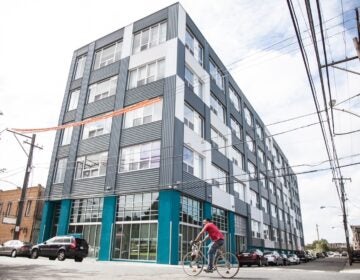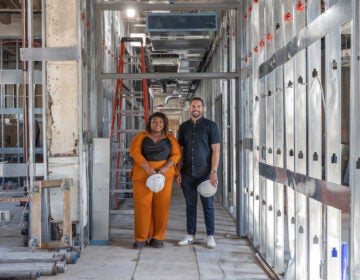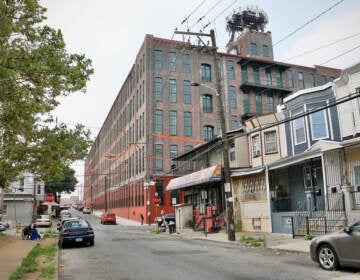For rent: Apartments under the ‘Eiffel Tower of Kensington’ — a giant milk bottle
Rents in the iconic former dairy will start at $925 for a studio and $1,750 for a two-bedroom.
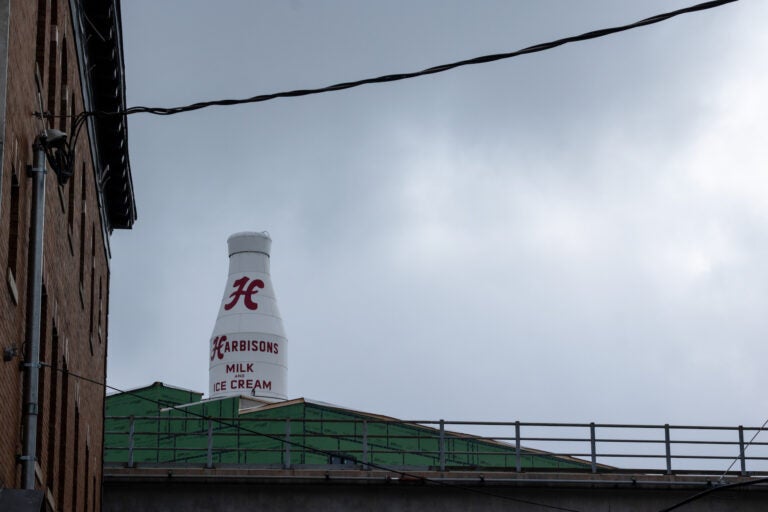
The recently renovated Harbison's Dairy bottle in Kensington. (Angela Gervasi/WHYY)
For 125 years, Harbison’s Dairy, a company founded by an Irish immigrant, manufactured milk, butter, and ice cream in Philadelphia.
Once the dairy closed in 1990, its Kensington-based plant began to deteriorate. So did the company’s 30,000-gallon water tower: the Kensington milk bottle, which served as a high-rise advertisement for the company.
In recent decades, the bottle began resembling “what I like to call ruin porn,” said Oscar Beisert, an architectural historian who fought for the structure’s preservation.
Rust. Chipped paint. Graffiti. It’s a common trajectory for Philadelphia’s historic buildings: neglect, decay, and possible demolition.
But Harbison’s Dairy met a different fate. Its historical designation, championed by Beisert and a slew of Kensington residents, protected it from demolition.
That became visible in early July, when Philly sign painter Gibbs Connors transformed the 25-foot dairy’s milk bottle — and with it, the Kensington skyline. The once-corroded tower sports a fresh, white coat of paint and the crimson Harbison’s logo.
It’s not exactly a return to the past. Harbison’s Dairy has been defunct for decades, and still is. The building beneath the bottle will hold boutique apartments and a promotional products company — both owned by entrepreneur Sterling Wilson.
Restoring the building was a challenge, but a rewarding one, said Wilson, who worked with the Philadelphia Historical Commission to maintain the building’s heritage.
“Being able to bring it back to life and restore a real icon of that neighborhood, it’s an honor,” he added.
Wilson’s apartment complex, named Harbisons Dairy, leans into the building’s industrial history. Still, the complex will include modern additions: a fitness center, coffee shop, and dog park roofdeck. Wilson said he worked with PNC Bank’s community development team to drive down the rent. Studio apartments start at $925 per month while two-bedrooms start at $1,750. The developer expects them to be available for occupancy this fall.
It’s not lost on Beisert that the building won’t be so working-class. Still, he said, the survival of a structure he has called “the Eiffel Tower of Kensington” is a victory.
“If it had been demolished, it would have been luxury condos or townhouses there anyway,” Beisert said. “Even if it isn’t a perfect result, it still has a greater sense of public good that … this landmark would be preserved.”
While Harbison’s Dairy will be reborn, other historical buildings have fallen. In 2019, the number of demolition permits filed in the city hit a historic peak. The city’s Historical Commission is scheduled to vote Friday on whether or not the owner of another nearby landmark, St. Laurentius Church, can demolish the structure.
Historical preservation is especially difficult during a “development boom where people just want to build townhouses,” Beisert said. In Kensington, home values have risen to half a million dollars, drawing developers to the area. With the city’s tax abatement for development soon to be reduced in value, that boom is only intensifying as developers race to get projects moving before the policy change.
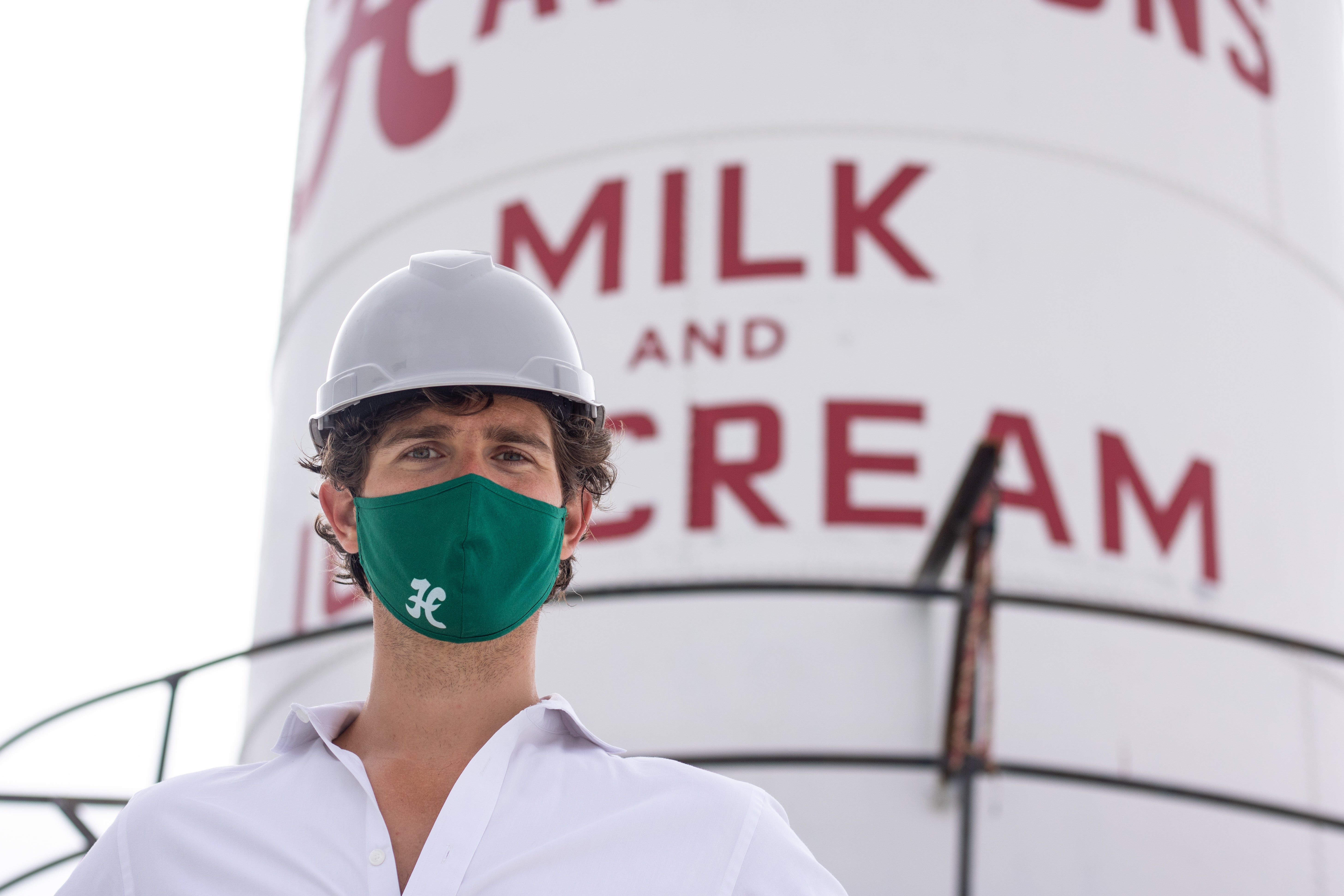
A landmark in the sky
As a child, Ken Milano rode the Market-Frankford line — often running between the subway cars to play tag with neighborhood friends. To gauge how close he was to his home, Milano simply glanced through the subway’s window and scanned Kensington’s skyline.
“When we were several El stops away, you could see the big milk bottle,” said Milano, now a local historian. “So that was always a big deal. ‘Oh, we’re almost home!’”
Harbison’s beginnings were humble. When Robert Harbison arrived in Kensington, he sometimes ladled fresh milk directly into the pitchers of local customers, according to the nomination for historic designation submitted to the Philadelphia Historical Commission. In time, the company began pasteurizing its milk: a practice that modernized the dairy product and reduced infant mortality.
“You realize how much this company touched the lives of all these people that they served,” Beisert said. “If you cook in the morning, you know, mom needed milk.”
At its height, the dairy hosted locations in Kensington, Frankford, Tioga, and Bucks County. One plant — and the milk bottle Milano saw from the El— remain intact. The vast building sits on Coral and Susquehanna streets, steps away from Norris Square and the rumbling elevated train.
The Kensington-based dairy business employed hundreds at a time, delivering milk to customers via 385 delivery routes.
In the 1970s, after long nights spent roaming the neighborhood, Milano and his friends snagged freshly baked rolls and cold bottles of Harbison’s milk. Years later, Milano would publish half a dozen books exploring local history.

A fight for preservation
Several years ago, Kensington residents drafted a landmark nomination for Harbison’s Dairy. At first glance, Beisert knew revision would be necessary.
So Beisert and the Keeping Society submitted a full nomination on a volunteer basis. The 95-page document outlines the buildings’ dimensions, the history of the dairy, and highlights specific criteria for historical designation.
Nominating a historical landmark is an intricate task, Beisert said.
“Because it essentially ends up being like a legal document. You’re documenting that this is officially historic,” he explained.
But without nomination, the structure may not have survived. In 2018, the building’s owner, Fozan Ehmedi, argued that the building, though not the bottle, warranted demolition.
“The familiar icon is the water tower,” attorney William Martin told the historical commission. “Not the rest, which is just a workaday industrial building.”
Ehmedi’s team also argued that the building deteriorated over time and was no longer usable as a warehouse for his grocery store, Cousin’s Supermarket.
The arguments didn’t hold weight with the Philadelphia Historical Commission, who unanimously voted to designate the bottle and building.
When asked whether the restored milk bottle was a win for longtime Kensington residents like himself, Milano replied: “Is there anybody left in that area? We call ourselves the leftovers. The few, the proud, the leftovers.”

Get daily updates from WHYY News!
WHYY is your source for fact-based, in-depth journalism and information. As a nonprofit organization, we rely on financial support from readers like you. Please give today.






